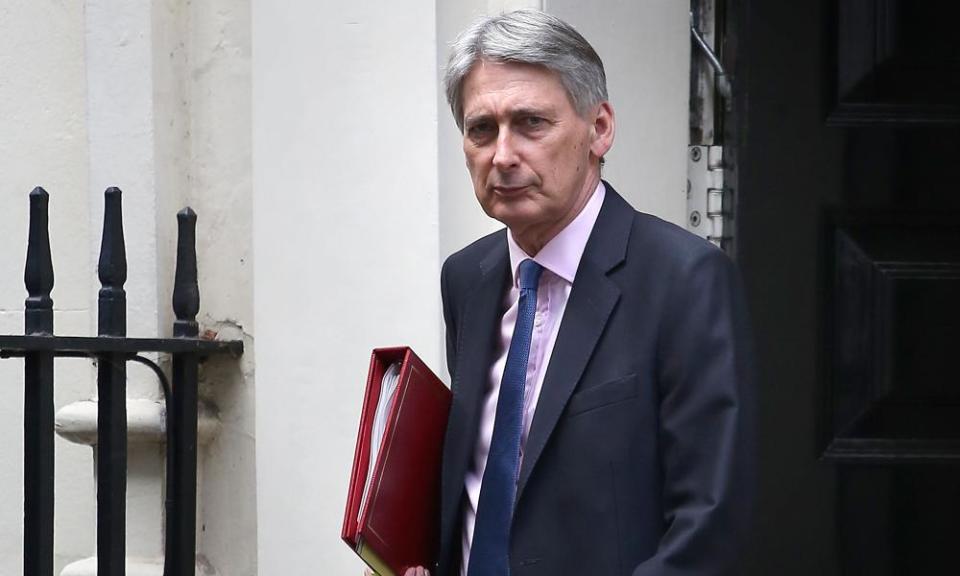UK government borrowing at lowest level since 2008 financial crisis

Government borrowing fell to the lowest level since the financial crisis in the year to the end of March as the economy proved more resilient than expected in the aftermath of the Brexit vote.
Borrowing fell by £20bn to £52bn in the 2016-17 financial year after economic growth helped drive tax receipts higher, narrowing the gap between what the government spends and earns.
It was the lowest level of annual borrowing since 2007-08, according to the Office for National Statistics, before the full impact of the financial crisis was reflected in the public finances.
The lower deficit meant the chancellor, Philip Hammond, essentially met his £51.7bn target for borrowing in 2016-17, as outlined by the Treasury’s independent forecaster, the Office for Budget Responsibility, at the time of the budget in March.
Howard Archer, the chief UK economist at IHS Markit, said the lower deficit would be welcome news for Hammond.
“This is helpful for the chancellor’s and government’s credibility, which is all the more welcome given the looming snap general election,” he said. “Philip Hammond is clearly keen to keep fiscal ammunition up his sleeve – due to the major uncertainties and downside risks that the economy faces as it navigates its way out of the EU.”
However, borrowing for the final month of the financial year was almost £2bn more than expected at £5.1bn. It was the highest borrowing in the month of March since 2015.
The deficit has been falling since 2012-13, having peaked at almost £152bn during the financial crisis in 2009-10. However, the OBR expects borrowing to rise again this year, to £55.2bn, partly due to one-off factors but also because of slowing growth as consumers rein in spending in response to rising shop prices.
Hammond conceded last November that Brexit would weigh on the public finances, abandoning plans to run a surplus by the end of the decade.
John Hawksworth, the chief economist at PwC, said the government would have to make difficult decisions on tax and spending.
“It is good news that the deficit is coming down, but it is too soon to be complacent about the state of the public finances. In the longer term an ageing population and rising healthcare costs will also put pressure on the public finances,” he said.
“So while the deficit is now approaching a more sustainable level, there will still be some tough choices ahead on tax and spending for the next government.”
Responding to the latest figures, the OBR cautioned that 2016-17 borrowing was likely to be revised over the coming months, because some of the data at this stage – such as cash VAT receipts – was based on forecasts and estimates.
“The figures typically take some months to settle down and revisions can be significant. In the six years since 2010-11, initial estimates of net borrowing have been revised down by an average of £2.8bn over the subsequent 12 months,” it said.
In a separate report, the ONS said the richest fifth of UK households had an average income before tax and benefits of £84,700 in the financial year ending 2016, compared with £7,200 for the poorest. That was a ratio of 12 to one, down from 14 to one a year earlier following an increase in pay the poorest fifth.
The ratio between the average income of the top and bottom fifth of households –£63,300 and £17,200 respectively – is reduced to less than four to one after accounting for benefits and taxes.
However, the Equality Trust, which campaigns to reduce economic inequality, said its own analysis of the figures showed the richest 10% of households pay a smaller proportion of their income in tax than the poorest 10% of households.
“When the super-rich are paying less in taxes than their cleaners, you know something has gone disastrously wrong with our broken, regressive tax system,” said Wanda Wyporska, the executive director of the Equality Trust.
“Time after time we see sensible reforms attacked and rejected in favour of tax cuts for billionaires. These do nothing for ordinary people struggling to keep a roof over their head.”

 Yahoo Finance
Yahoo Finance 